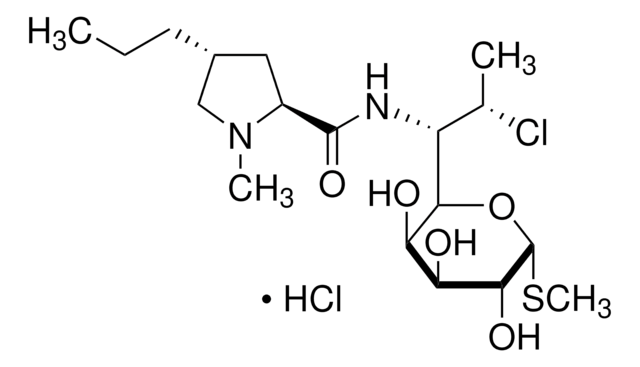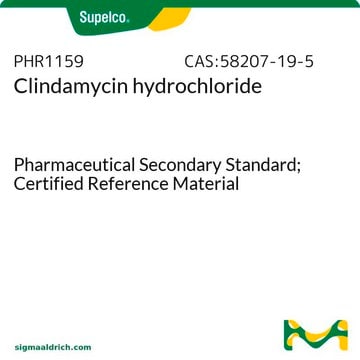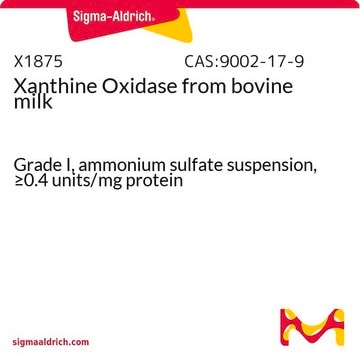This product is predominantly (>95%) in the oxidized form.
C7752
Citocromo c from equine heart
≥95% based on Mol. Wt. 12,384 basis
Sinónimos:
Citocromo c from horse heart
Seleccione un Tamaño
Seleccione un Tamaño
About This Item
Productos recomendados
biological source
horse heart
Quality Level
assay
≥95% (SDS-PAGE)
≥95% based on Mol. Wt. 12,384 basis
form
powder
mol wt
12,384
technique(s)
cell culture | mammalian: suitable
suitability
suitable for molecular biology
UniProt accession no.
storage temp.
−20°C
Gene Information
horse ... CYCS(100053958)
¿Está buscando productos similares? Visita Guía de comparación de productos
Application
El citocromo c es adecuado para utilizar como componente del tampón fosfato para la detección y la evaluación de la actividad del complejo IV mediante electroforesis en gel Blue Native (BN-PAGE). También puede utilizarse para la detección de anión superóxido extracelular (ECSA) en fagocitos renales aislados.
Biochem/physiol Actions
Preparation Note
Other Notes
Application
also commonly purchased with this product
Storage Class
11 - Combustible Solids
wgk_germany
WGK 3
flash_point_f
Not applicable
flash_point_c
Not applicable
ppe
Eyeshields, Gloves, type N95 (US)
Elija entre una de las versiones más recientes:
Certificados de análisis (COA)
¿No ve la versión correcta?
Si necesita una versión concreta, puede buscar un certificado específico por el número de lote.
¿Ya tiene este producto?
Encuentre la documentación para los productos que ha comprado recientemente en la Biblioteca de documentos.
Los clientes también vieron
Protocolos
Enzymatic Assay of Superoxide Dismutase
Chromatograms
application for HPLCapplication for HPLCapplication for HPLC-
Is Product C7752, Cytochrome c, predominantly in the oxidized form or the reduced form?
1 answer-
Helpful?
-
-
I see that you list several horse heart cytochrome c products. What are the differences, and which one should I choose?
1 answer-
Product No. C2506 is prepared with trichloroacetic acid (TCA), whereas C7752 is prepared with the milder acetic acid. The TCA method may reduce the amount of superoxide dismutase (SOD) present, but tends to cause dimerization or acid-modified structures of cytochrome c. In contrast, acetic acid preparations may have slightly higher amounts of SOD, but a lower proportion of dimeric cytochrome c. So C2506 would be recommended for enzyme activity studies that require low SOD, whereas C7752 is recommended for structural studies or binding studies, or for enzyme activity studies where possible SOD contamination is not a problem. Product No. C2867 is prepared from C2506; it is a BioUtra grade product, greater than or equal to 99% pure as determined by SDS-PAGE. It is recommended when an ultra-high purity is required. Product No. C3256 is also prepared from C7752; it is isolated by ion-exchange chromatography. This fraction shows a high rate of ascorbic acid oxidation, but low activity in a cytochrome oxidase system. Product No. C7150 is also prepared from C7752; it is suitable for use as a gel filtration molecular weight marker.
Helpful?
-
-
What is the Department of Transportation shipping information for this product?
1 answer-
Transportation information can be found in Section 14 of the product's (M)SDS.To access the shipping information for this material, use the link on the product detail page for the product.
Helpful?
-
-
How do I determine how much of Product C7752, Cytochrome c, is in the oxidized form, and how much is reduced?
1 answer-
This is determined by a spectral assay. The detailed assay procedure (operating procedure #11252) may be requested from Sigma St. Louis Technical Service ([email protected]).
Helpful?
-
-
How should I store solutions of Product C7752, Cytochrome c?
1 answer-
Our general recommendations are as follows: Store at -20 °C (freezer) for up to six months. Store at 2-8 °C (refrigerator) for up to two weeks. Store at 20-25 °C (room temperature) for up to three days. According to J. Biol. Chem, 237, 2161-2174 (1962), cytochrome c is stable to boiling, and over an unusually wide range of pH values. However, it denatures readily at extreme pH (low or high), and in high concentrations of organic solvents, such as ethanol or acetone.
Helpful?
-
Active Filters
Nuestro equipo de científicos tiene experiencia en todas las áreas de investigación: Ciencias de la vida, Ciencia de los materiales, Síntesis química, Cromatografía, Analítica y muchas otras.
Póngase en contacto con el Servicio técnico







